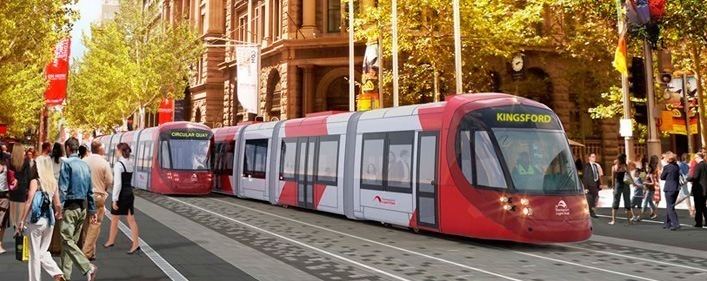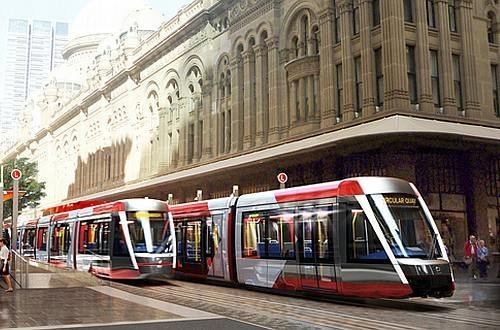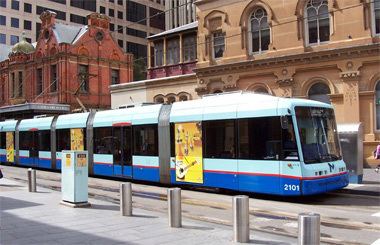Locale Sydney Annual ridership 9.7 million in 2015–16 Number of stations 23 First service 31 August 1997 | Transit type Light rail/Tram Operator(s) Transdev Sydney Number of lines 1 | |
 | ||
Website www.transdevsydney.com.au Began operation 31 August 1997 (Dulwich Hill Line) Owner Transport for New South Wales | ||
The Sydney light rail network is a tram or light rail system serving the Australian city of Sydney, New South Wales. The network presently consists of a single 12.8-kilometre (8 mi) line of 23 stations. A second line is under construction and two further lines serving Western Sydney have been announced. The network is controlled by the New South Wales Government's transport authority, Transport for NSW, and is part of the authority's Opal ticketing system. In 2015-16, 9.7 million passenger journeys were made on the network.
Contents
- History
- Ownership and operation
- Patronage
- L1 Dulwich Hill Line
- CBD and South East line
- Parramatta lines
- Tram fleet
- Urbos 3
- Citadis X05
- Variotram
- Urbos 2
- Ticketing and fares
- Potential extensions
- Anzac Parade
- Green Square
- The Bays Precinct
- Bondi
- References

History

In the 19th and early 20th centuries, Sydney developed an extensive tram network, which grew to be one of the largest in the world. The increasing rate of private car ownership and the perception that trams contributed to traffic congestion led to the progressive replacement of tram services with buses, with the final section of the tram network closing in February 1961.

In the 1980s and 1990s, the inner city areas of Darling Harbour and Pyrmont were the subject of an urban renewal program. In 1988 the Sydney Monorail opened, connecting Darling Harbour to the Central Business District. With poor integration between the monorail and other transport modes, and the increasing redevelopment of the Pyrmont peninsula – including the establishment of Sydney's first legal casino – it was decided to convert a disused section of the Metropolitan Goods railway line into a light rail line. A section of track between Pyrmont and Haymarket was upgraded and a new on-street section constructed to link the line to Central railway station. The line was set up as a public-private partnership and opened in August 1997 as the Sydney Light Rail.

The line's owner soon made proposals for a western extension along the disused section of the goods line, plus a new line through the Central Business District from Central to Circular Quay. The western extension opened in 2000, but the company was unsuccessful in its attempts to develop a CBD line, which saw development of light rail stagnate for the remainder of the decade. By contrast, the 2010s have seen major expansion and reform of light rail in Sydney including the announcement and delivery of multiple new infrastructure projects, integration of ticketing with the city's other transport modes, the introduction of new trams and the transfer of the network to full public ownership. The extensions announced during the decade total almost 40-kilometres. If all projects are completed, the network would expand in size from 7.2-kilometres at the start of the decade to approximately 50-kilometres.
Ownership and operation

Under the terms of the original line's public-private partnership, the Sydney Light Rail Company (SLRC) was awarded a 30.5-year concession, allowing it to operate the line until February 2028, when ownership would pass to the New South Wales Government. The contract gave the company significant control over the commercial arrangements relating to future extensions or interconnecting lines. SLRC contracted operation of the line to TNT, who also owned the monorail.

A major change occurred in August 1998 when the light rail and monorail effectively merged. TNT sold the monorail to CGEA Transport and the companies owning SLRC, and CGEA Transport took over operation of both services. CGEA Transport and its successors have operated the inner city light rail network ever since. The company controlling the light rail and monorail became known as Metro Transport Sydney and the systems were renamed Metro Light Rail and Metro Monorail.
The Government of New South Wales purchased Metro Transport Sydney on 23 March 2012 for $19.8 million, and the company was placed under the control of Transport for NSW. The purchase removed the contractual restrictions on expanding the light rail network and allowed the government to dismantle the monorail, assisting its plans to redevelop the Sydney Convention and Exhibition Centre. The monorail closed on 30 June 2013. From 1 July, the Metro Light Rail brand was phased out as part of a broader rebranding and reorganisation of public transport services in New South Wales. The process of shutting down Metro Transport Sydney and transferring assets to Transport for NSW was completed in September 2014.
Following the announcement of the CBD and South East Light Rail, the government decided to group the contract covering construction of the new line with the operation and maintenance both lines of the inner city network. In December 2014, Transport for NSW awarded the contract to the ALTRAC Light Rail consortium, consisting of Alstom, Transdev, Acciona Infrastructure & Capella Capital. The operating contract commenced on 1 July 2015 and runs until 2034. Transdev Sydney operate and maintain the network as part of the consortium.
Patronage
The following table lists patronage figures for the network (in millions of journeys) during the corresponding financial year. Australia's financial years start on 1 July and end on 30 June. Major events that affected the number of journeys made or how patronage is measured are included as notes.
L1 Dulwich Hill Line
The Inner West Light Rail – branded as the L1 Dulwich Hill Line – is the network's original line. It connects the Inner Western suburbs with the Pyrmont peninsula, Darling Harbour and the southern end of the Central Business District. The line operates along a former freight railway, with a short on-street section at the city end. The route opened between Central Railway Station in the city and Wentworth Park in August 1997. The line was extended west from Wentworth Park to Lilyfield in August 2000 and then south-west from Lilyfield to Dulwich Hill in March 2014.
CBD and South East line
The CBD and South East Light Rail is a future line that will operate from Circular Quay at the northern end of the Central Business District to Central station at the southern end, then continuing to the south-eastern suburbs. The line is being built to reduce bus congestion in the CBD and provide higher capacity public transport to the Sydney Football Stadium, Sydney Cricket Ground, Randwick Racecourse and the University of New South Wales, which are currently served only by buses. In contrast to the Inner West Light Rail, the route is mostly on-street and follows a similar path to routes used by the former tramway network. Major construction began in October 2015. The line is projected to open in early 2019.
Parramatta lines
Parramatta Light Rail is the name given to two planned lines that converge on the Western Sydney centre of Parramatta.
The first line runs from Carlingford to Westmead via the Parramatta CBD. It includes the conversion of most of the under-utilised existing heavy rail Carlingford line to light rail standards. Construction is expected to begin in 2018 and be completed by 2023.
The second line branches from the first at Camellia and heads to Strathfield, passing through the Sydney Olympic Park events precinct and industrial lands slated for urban renewal. Construction of this line has been deferred.
The lines will have no connection to the Inner West or CBD and South East lines.
Tram fleet
All services are operated by a single class of trams. A second class will be added to the fleet to operate services on the CBD and South East Light Rail. All trams to have operated on the system have been articulated, low floor and bi-directional. The system uses standard gauge track and 750 volt direct current electrification.
Urbos 3
Services on the Inner West Light Rail are provided by a fleet of twelve Urbos 3 trams. A tender for six trams was awarded to Spanish company Construcciones y Auxiliar de Ferrocarriles (CAF) on 16 August 2012. The trams were ordered to service the Dulwich Hill extension and increase service frequencies. The first tram arrived in Sydney on 19 December 2013 and entered service on 24 July 2014.
On 11 October 2013, the Government announced an order for six additional Urbos 3 trams to replace the Variotrams that had been providing services on the Inner West Light Rail since the first section of the line opened in 1997. All trams from the additional order entered service by the end of June 2015.
The Urbos 3 trams are approximately 33 metres long and feature two double and two single doors on each side. Seats are generally in the transverse configuration – at 90 degrees to the sides of the vehicle. Digital voice announcements and internal dot-matrix displays provide information about the next stop. The trams are numbered 2112, 2114–2124.
Citadis X05
As part of the winning consortium to build and operate the CBD and South East Light Rail, Alstom will supply thirty coupled pairs of Citadis X05 trams to provide the services. Original plans for the line intended for the trams to be approximately 45 metres long and use batteries to offer wire free operation in a section of George Street between Bathurst Street and Circular Quay. In December 2014, it was announced that the design of the trams would be lengthened to approximately 67 metres and that Alstom's proprietary Aesthetic Power Solution ground-level power supply technology would be used in place of batteries.
Variotram
The network's original rolling stock was the Variotram which was introduced with the opening of the first section of the Inner West Light Rail in 1997. Seven German-designed vehicles were manufactured in Dandenong, Victoria by Adtranz. The Variotram design is modular and was extended for the Sydney system. The capacity of the vehicles is 217 passengers, of which 74 are seated. On tests up to three trams have been coupled together allowing a maximum capacity of 600 passengers if required. They were numbered 2101–2107, continuing the Sydney trams sequence that finished at 2087 with the last Sydney R1-Class Tram.
The vehicles have a floor to rail height of 30 centimetres and the bogies have no axles between the wheels and are powered with hub motors. The design weight was reduced to compensate for the addition of climate-control air-conditioning equipment. Each tram is fitted with three double doors each side which have enhanced safety systems with obstacle detection interlocked with the traction system. Seats are generally in the transverse configuration – at 90 degrees to the sides of the vehicle. In 2014, the original external destination rolls were replaced with dot-matrix displays and digital voice announcements were installed. There are no internal displays. The last Variotram was withdrawn from service after operating overnight between Central and The Star on 27/28 May 2015.
Urbos 2
Four leased Urbos 2 trams were introduced on the Inner West Light Rail in 2014. The trams entered service to coincide with the extension of the line to Dulwich Hill, supplementing the Variotrams and ensuring service frequencies on the line could be maintained. The four trams had previously operated in Spain. Three units (2108–2110) were from Vélez-Málaga, where they operated between 2006 and 2012. The other tram (2111) was from Seville. The first tram arrived in Sydney on 4 September 2013. Delivery was completed in November. The trams entered service on 22 March 2014, five days before the opening of the extension to Dulwich Hill. Following the introduction of the Urbos 3 trams in July 2014, the Urbos 2s were withdrawn and returned to Spain. The Urbos 2s were unpopular with passengers and attracted complaints.
The trams featured four double and two single doors on each side. The seats were unpadded and were generally built in the longitudinal seating configuration – running parallel to the sides of the tram body. Digital voice announcements and internal dot-matrix displays provided information about the next stop.
Ticketing and fares
The light rail network uses the smartcard-based Opal ticketing system, which was introduced to the network on 1 December 2014. Opal is also valid on bus, train and ferry services but separate fares apply for these modes. Opal's light rail fares are the same as those for buses but the fares are not combined when interchanging between the two modes. This is due to change once the CBD and South East Light Rail opens; all light rail passengers interchanging with buses will only pay one fare, calculated from the start of their trip on one mode to the end of their trip on the other. Light rail stops feature Opal top-up machines that also sell Opal single trip tickets. The single trip tickets are more expensive than the standard Opal fare. They are only valid for travel on light rail and must be used on the day of purchase. The following table lists Opal fares for reusable smartcards and single trip tickets:
Card fares as of 4 January 2015. Single trip fares as of 5 September 2016.
Fares are calculated using straight line distance between the origin and destination stops. No two stops on the existing line are located more than 8 kilometres from each other using this method so the 8 km+ band doesn't apply to light rail services.
When it first opened, the Inner West Light Rail used its own paper-based ticketing system. Paper tickets were originally sold from ticket machines on stop platforms but were later issued by conductors on board the trams. During the 2010s this system gradually merged with the broader Sydney ticketing system, culminating in the introduction of Opal and the withdrawal of all other tickets. This process was completed on 1 August 2016.
Potential extensions
Several transport corridors have significant potential to allow for the growth of the network beyond its current route structure.
In December 2012, the New South Wales Government released a policy document entitled Sydney's Light Rail Future. The document identified the following priority corridors for investigation by Transport for NSW:
Anzac Parade
Transport for NSW is investigating an extension of the CBD and South East line along the southern Anzac Parade corridor. Three potential options are being examined; a 1.9 kilometre extension to Maroubra Junction, a 5.1 kilometre extension to Malabar and a 8.2 kilometre extension to La Perouse.
Green Square
The City of Sydney Council has recommended that a Light Rail link be built from the city to Green Square, to service the commercial and residential developments currently being constructed in the area and has spent more than $30 million buying land for a light rail corridor. In July 2015, New South Wales Transport Minister Andrew Constance stated that the area was likely to be served by a light rail link in the future. This led to a decision in October by the City of Sydney to allocate $445 000 to develop plans for a light rail line from the city to Green Square. The City estimated a link would cost $350–500 million to build.
The Bays Precinct
The Bays Precinct is a large waterfront area to the west of the Sydney CBD being proposed for urban renewal by the New South Wales Government. The southern part of the precinct is served by the existing Inner West Light Rail. A planning document released by the government in October 2015 suggested light rail could be extended to the northern part of the precinct, possibly utilising the Glebe Island Bridge.
Bondi
The Waverley Municipal Council advocates the extension of the light rail network to link the current infrastructure to Bondi Junction and Bondi Beach. The council commissioned AECOM to undertake a feasibility assessment of the reintroduction of light rail on the corridor between Bondi Beach and Bondi Junction (Stage 1) and onto the CBD (Stage 2) to achieve mass transit of passengers and formally requested Transport for NSW consider the CBD to Bondi Beach corridor as a priority route in the Sydney Light Rail Plan. The assessment, published in 2013, recommended the construction of the light rail along a 3.9 km route from Bondi Junction to Bondi Beach along Bondi Road. It investigated three potential connections to the existing light rail network, via Randwick, via Moore Park Road and via Oxford Street but recommended that a more detailed feasibility assessment was necessary to select the route.
